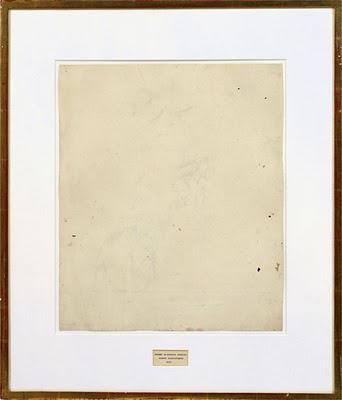 Erased de Kooning, Robert Rauschenberg, 1953
Erased de Kooning, Robert Rauschenberg, 1953 A young Robert Rauschenberg walks into the studio of one Williem de Kooning. They talk for a while, one would presume they discussed the weather and the state of their careers. Eventually, with some hesitation the young artists gets to the point of his visit:
[...] hemming and hawing, [Rauschenberg] asked the older man if he might have a drawing. that in itself was not unusual. Artist friends often exchanged work. But Rauschenberg wanted the drawing not to hang in his studio, but to erase.De Kooning knew exactly what Rauschenberg was doing. Robert Rauschenberg wasn't just looking to collaborate with de Kooning. He also wasn't just wanting to add to his series of mono-chromatic paintings. Rauschenberg was looking to erase de Kooning, in a more symbolic way. This tongue-in-cheek Dadaist gesture, was in essence the ritualistic murder of Abstract Expressionism done through one of its heroes.
There was a moment of silence. The younger man wanted de Kooning to hurry up and just give him a minor drawing so he could quickly leave. But de Kooning instead chose to take his time.As evidenced, if Abstract Expressionism was to be killed in order to give way to the new wave of artists, then de Kooning certainly made it clear that he would allow it, but under his terms. The "No more heroes" stance of the act was certainly an omen for the Ab.Ex. movement and the subsequent birth of Pop.
[...] he did not let the affair become just an inside joke that could easily be dismissed. he made the younger artist squirm, for the death of a father must not come too easily to a son., especially if that son is an artist. "He really made me suffer," Rauschenberg said, referring to the elaborate process that de Kooning established for the execution. De Kooning brought over a portfolio of drawings and began leafing through them. At last, he seemed to settle on one. he looked at it. But then slipped the drawing back into the portfolio. "No," he said, "I want to give you one that I'll miss."
De Kooning brought over a second portfolio. He leafed through it as slowly as he had the first, examining one drawing and then the next. "These I would miss," he said. "I like them." He seemed to settle on a particular image. "No," he said at last, "I want it to be very hard to erase"
Here is the man himself, explaining the event.
[Excerpts were taken from de Kooning: An American Master, by Mark Stevens.]

